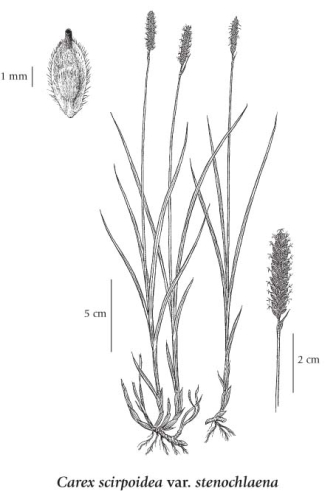Carex scirpoidea subsp. stenochlaena Michx.
single-spike sedge
Cyperaceae (Sedge family)
Introduction to Vascular Plants
single-spike sedge
Cyperaceae (Sedge family)
Introduction to Vascular Plants
Map click to expand contents
Distribution of Carex scirpoidea subsp. stenochlaena
Click here to view the full interactive map and legend
Species Information click to expand contents
General:
Perennial herb from stout, creeping rhizomes; stems 10-60 cm tall, arising singly or a few together, equalling or longer than the leaves.
Leaves:
Sheaths tight, hairy below; ligules short; blades 2 to 4 per stem, flat or somewhat channeled, borne on the lower 1/3 to 1/2 of the stem, 1-3 mm wide.
Flowers:
Spikes solitary, either male or female on separate plants, the male spikes cylindrical, erect, the female spikes many-flowered, similar, 1.5-4 cm long, 2.5-5 mm wide, unstalked; bracts scalelike, prolonged into awns up to 2 cm long or sometimes awnless.
Fruits:
Perigynia egg-shaped to elliptical or nearly globe-shaped, 2.5-4.5 mm long, 1-2 mm wide, appressed, slightly spreading at maturity, straw-coloured, short-hairy on the backs, especially towards the tips, obscurely several-nerved, unstalked to short-stalked, the beaks bidentate, evident, short, slender; female scales broadly egg-shaped, slightly shorter and as wide as the perigynia, rounded, brown to blackish, the centres pale, the margins narrowly translucent; stigmas 3; achenes 3-angled, about 1.5-2 mm long.
Notes:
Three varieties occur in BC.
1. Perigynia egg-shaped to elliptical, mostly 3-4.5 mm long and more than 2.5 times as long as wide; achenes distinctly stalked; plants of moist sites mainly of W BC..................... var. stenochlaena Holm
1. Perigynia nearly globe-shaped, mostly 2.5-3 mm long and less than 2.5 times as long as wide; achenes short-stalked or unstalked; plants of mesic to dry sites in SC BC or N and SE BC.
2. Stems with the lowest leaves reduced to scales, the flowering ones arising from the current year's vegetative shoots which have conspicuous basal scale leaves; plants mainly of N and SE BC......................... var. scirpoidea
2. Stems with the lowest leaves well developed, clothed at bases with the conspicuous dried-up leaves of the previous year; plants mainly in the Cascades...................... var. pseudoscirpoidea (Rydb.) Cronq.
Illustration click to expand contents

If more than one illustration is available for a species (e.g., separate illustrations were provided for two subspecies) then links to the separate images will be provided below. Note that individual subspecies or varietal illustrations are not always available.
Illustration Source: The Illustrated Flora of British Columbia
Ecology click to expand contents
Ecological Framework for Carex scirpoidea ssp. stenochlaena
The table below shows the species-specific information calculated from
original data (BEC database) provided by the BC Ministry of Forests and Range.
(Updated August, 2013)
The table below shows the species-specific information calculated from
original data (BEC database) provided by the BC Ministry of Forests and Range.
(Updated August, 2013)
| Site Information |
Value / Class |
||
|
Avg |
Min |
Max |
|
| Elevation
(metres) |
1095 | 1095 | 1095 |
| Slope
Gradient (%) |
0 | 0 | 0 |
|
Aspect (degrees) |
0 | ||
| Soil
Moisture Regime (SMR) [0 - very xeric; 4 - mesic; 8 - hydric] |
5 | 5 | 5 |
| Modal
Nutrient Regime
Class |
F | ||
| #
of field plots species was recorded in: |
1 | ||
| Modal
BEC Zone Class |
IDF | ||
|
All BEC Zones (# of stations/zone) species was recorded in |
IDF(1) | ||
|
Source:
Klinkenberg 2013
|
|||
Habitat and Range click to expand contents
Moist meadows and streambanks (var. stenochlaena) or mesic to dry meadows and open rocky slopes (var. pseudoscirpoidea and var. scirpoidea) from the montane to alpine zones; var. pseudoscirpoidea - locally frequent in the Cascade Mountains, rare elsewhere in SC BC; var. scirpoidea - frequent in N and SE BC; var. stenochlaena - frequent in W BC, less frequent eastward; var. pseudoscirpoidea - S to CO, UT and CA; var. scirpoidea - amphiberingian, N to AK, YT and NT, E to NF and S to NH, MI, CO and WA; Greenland, E Asia; var. stenochlaena - N to AK and YT and S to MT, ID and E OR.
Status Information click to expand contents
| Scientific Name | Origin Status | Provincial Status | BC List (Red Blue List) | COSEWIC |
|---|---|---|---|---|
| Carex scirpoidea ssp. pseudoscirpoidea | Native | S3S5 | Yellow | Not Listed |
| Carex scirpoidea ssp. scirpoidea | Native | S5 | Yellow | Not Listed |
| Carex scirpoidea ssp. stenochlaena | Native | S5? | Yellow | Not Listed |
BC Ministry of Environment: BC Species and Ecosystems Explorer.
Synonyms click to expand contents
Synonyms and Alternate Names:
Carex scirpoidea Michx.
